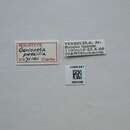Comprehensive Description
provided by Smithsonian Contributions to Zoology
Gonionota poecilia
Alar expanse 16–19 mm.
Labial palpus light ochraceous buff; second segment irrorate with ochraceous tawny; posterior tuft grayish fuscous; third segment similar but irrorate with reddish scales and apex ocherous white. Antenna buff with grayish fuscous annulations; scape grayish fuscous dorsally, buff ventrally. Head light avellaneous. Thorax sayal brown mixed with scarlet and orange yellow. Ground color of forewing sayal brown; dorsal two thirds mostly scarlet and orange-yellow blotches and spots set off by a fuscous reticulum; on basal third of dorsum a triangular spot of ground color, its base on dorsal edge; on basal third of costa an orange yellow triangle containing scarlet scales; a similarly colored wedge-shaped mark on outer third of costa; at basal third, in cell, a large white spot followed at end of cell by a similar, but smaller, spot; subterminally an outwardly curved row of fuscous dashes from vein 9 to vein 1c; terminal edge from apex around tornus to base of dorsum narrowly fuscous; cilia sayal brown.
Hindwing ocherous white, basally shading to clay color toward margins; termen narrowly dark clay color; cilia ocherous white at anal angle becoming darker toward apex. Foreleg light ochraceous buff; femur and tibia sayal brown on outer side, mid- and hindlegs light ochraceous buff; very sparsely irrorate with brownish. Abdomen deep olive buff dorsally, light ochraceous buff ventrally, irrorate with brown and fuscous scales.
Male genitalia slide JFGC 12015. Harpe broadest before middle, gradually tapered to a narrow, bluntly pointed cucullus; clasper a sclerotized rod terminating in a free knob clothed with one large and numerous small spines. Gnathos an oval spined knob. Uncus broad, flattened, dilated distally; socii short, digitate setaceous processes. Vinculum narrowly rounded. Tegumen about two thirds the length of harpe, broad basally. Anellus pear shape; from each corner, posteriorly, a long spine. Aedeagus strongly bent, sharply pointed distally; vesica unarmed.
Female genitalia slide JFGC 12085. Ostium slitlike. Genital plate very broad, rounded anteriorly; lamella antevaginalis and lamella postvaginalis membranous, granular. Antrum strongly sclerotized for a short distance inside ostium. Inception of ductus seminalis lateral, at junction of antrum and membranous part of ductus bursae. Ductus bursae membranous. Bursa copulatrix membranous, very finely granular posteriorly. Signum an elongate, sclerotized, dentate plate.
HOLOTYPE.—USNM 71101.
TYPE LOCALITY.—Venezuela, Aragua, Rancho Grande, 1100 m.
DISTRIBUTION.—Venezuela.
Described from the holotype, 12 and 7 paratypes, all from the same locality (January, October, and November dates, 1966, S. S. and W. D. Duckworth) and one (22–30. VI. 1967, R. W. Poole).
Superficially, poecilia resembles festicola more than it does anything else presently assigned to the genus, but is easily distinguished by the genitalia. In festicola there is a long, pointed process, parallel to costa, from base of harpe and a strongly recurved clasper from basal third of harpe (Clarke 1963: pl. 114: fig. 1b), both absent in poecilia. The vesica of festicola is armed, that of poecilia unarmed. The uncus is broad and flattened in poecilia, stalked in festicola. The female genitalia of festicola are unknown, so cannot be compared with poecilia.
- bibliographic citation
- Clarke, J. F. Gates. 1971. "Neotropical Microlepidoptera XIX: notes on and new species of Oecophoridae (Lepidoptera)." Smithsonian Contributions to Zoology. 1-39. https://doi.org/10.5479/si.00810282.95
Gonionota poecilia: Brief Summary
provided by wikipedia EN
Gonionota poecilia is a moth in the family Depressariidae. It was described by John Frederick Gates Clarke in 1971. It is found in Venezuela.
The wingspan is 16–19 mm. The forewings are sayal brown, with mostly scarlet and orange-yellow blotches and spots set off by a fuscous reticulum at the dorsal two thirds. On the basal third of the dorsum is a triangular spot of ground color, its base on the dorsal edge and on the basal third of the costa is an orange yellow triangle containing scarlet scales. A similarly colored wedge-shaped mark is found on the outer third of the costa and at the basal third, in the cell, is a large white spot followed at the end of the cell by a similar, but smaller, spot. Subterminally, an outwardly curved row of fuscous dashes runs from vein 9 to vein lc and the terminal edge from the apex around the tornus to the base of the dorsum is narrowly fuscous. The hindwings are ocherous white, basally shading to clay color toward the margins.
- license
- cc-by-sa-3.0
- copyright
- Wikipedia authors and editors

